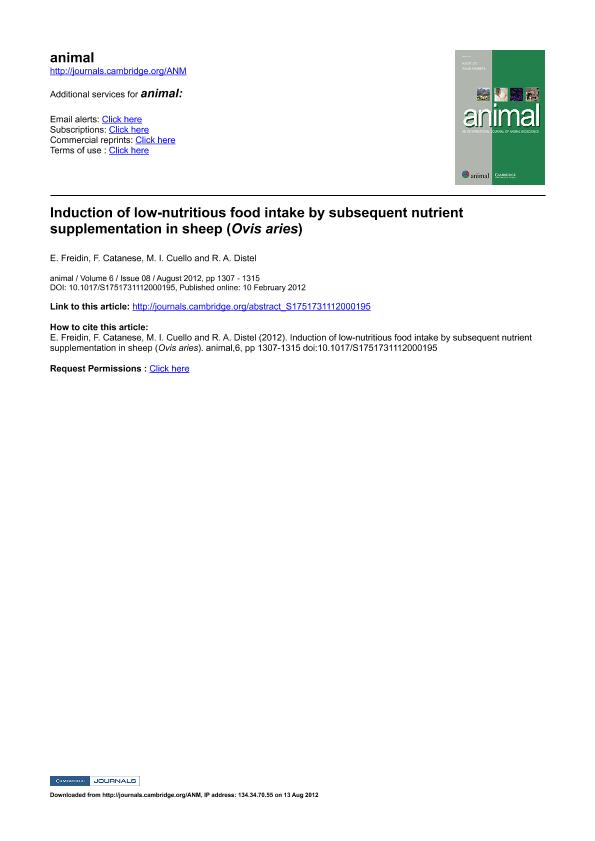Mostrar el registro sencillo del ítem
dc.contributor.author
Freidin, Esteban

dc.contributor.author
Catanese, Francisco Hernan

dc.contributor.author
Cuello, Marina Ines

dc.contributor.author
Distel, Roberto Alejandro

dc.date.available
2019-05-28T18:10:23Z
dc.date.issued
2012-08-10
dc.identifier.citation
Freidin, Esteban; Catanese, Francisco Hernan; Cuello, Marina Ines; Distel, Roberto Alejandro; Induction of low-nutritious food intake by subsequent nutrient supplementation in sheep (Ovis aries); Cambridge University Press; Animal; 6; 8; 10-8-2012; 1307-1315
dc.identifier.issn
1751-7311
dc.identifier.uri
http://hdl.handle.net/11336/77330
dc.description.abstract
Acceptance of and preference for a particular food depends not only on its intrinsic (e.g. nutritional) properties but also on expected or recent food experiences. An instance of this type of phenomenon has been called induction effect, which consists of an increased intake of a type of food when it precedes a hedonically preferred food in a sequence familiar to the animal, relative to controls that have access only to the less-preferred food. The purpose of our study was to assess intake induction of a low-nutritious food when followed by different high-nutritious supplements in sheep (Ovis aries). In this experiment, we ran a supplemented phase where animals fed oat hay (a low-nutritious food) in the first part of the daily feeding sessions followed by a supplement with either a high (soya bean meal; group GS) or a low (ground corn; group GC) protein-energy ratio in the second part ate more oat hay than controls that were fed oat hay in both parts of sessions (group GH). In addition, supplemented animals presented a stronger preference for oat hay over alfalfa hay than controls in a subsequent choice. When all animals received no food in the second part of the sessions (Non-supplemented phase), intake of oat hay converged to the control's intake level in all the groups, suggesting that the presence of supplements after access to oat hay was responsible for intake induction. Lastly, we repeated the supplemented phase with a different control group where animals received oat hay in the first part of the sessions and no food in the second part (group NF), thus equalizing groups in terms of the time of access to oat hay in a session. Groups GS and GC still developed higher intake of oat hay than group NF. In both supplemented phases of the experiment, we estimated animalsâ daily metabolizable energy (ME) and crude protein (CP) intake. CP intake was higher in group GS than in groups GC, GH and NF, but there was no difference between group GC and the controls. In turn, groups did not differ in ME intake in the First supplemented phase, and only group GS presented higher ME intake than the rest of the groups in the Second supplemented phase. Therefore, a nutritional account of the present induction effect seems insufficient. We propose that a learned association between oat hay and the post-ingestive feedback from the subsequent high-nutritious supplements underlay sheep's intake induction and increased preference for oat hay.
dc.format
application/pdf
dc.language.iso
eng
dc.publisher
Cambridge University Press

dc.rights
info:eu-repo/semantics/openAccess
dc.rights.uri
https://creativecommons.org/licenses/by-nc-nd/2.5/ar/
dc.subject
Intake Induction
dc.subject
Low-Nutritious Food
dc.subject
Nutrient Supplementation
dc.subject
Ruminants
dc.subject
Sheep
dc.subject.classification
Otras Producción Animal y Lechería

dc.subject.classification
Producción Animal y Lechería

dc.subject.classification
CIENCIAS AGRÍCOLAS

dc.title
Induction of low-nutritious food intake by subsequent nutrient supplementation in sheep (Ovis aries)
dc.type
info:eu-repo/semantics/article
dc.type
info:ar-repo/semantics/artículo
dc.type
info:eu-repo/semantics/publishedVersion
dc.date.updated
2019-05-14T17:41:19Z
dc.identifier.eissn
1751-732X
dc.journal.volume
6
dc.journal.number
8
dc.journal.pagination
1307-1315
dc.journal.pais
Reino Unido

dc.journal.ciudad
Cambridge
dc.description.fil
Fil: Freidin, Esteban. Consejo Nacional de Investigaciones Científicas y Técnicas. Centro Científico Tecnológico Conicet - Bahía Blanca. Centro de Recursos Naturales Renovables de la Zona Semiárida. Universidad Nacional del Sur. Centro de Recursos Naturales Renovables de la Zona Semiárida; Argentina
dc.description.fil
Fil: Catanese, Francisco Hernan. Consejo Nacional de Investigaciones Científicas y Técnicas. Centro Científico Tecnológico Conicet - Bahía Blanca. Centro de Recursos Naturales Renovables de la Zona Semiárida. Universidad Nacional del Sur. Centro de Recursos Naturales Renovables de la Zona Semiárida; Argentina. Universidad Nacional del Sur. Departamento de Agronomía; Argentina
dc.description.fil
Fil: Cuello, Marina Ines. Consejo Nacional de Investigaciones Científicas y Técnicas. Centro Científico Tecnológico Conicet - Bahía Blanca. Centro de Recursos Naturales Renovables de la Zona Semiárida. Universidad Nacional del Sur. Centro de Recursos Naturales Renovables de la Zona Semiárida; Argentina
dc.description.fil
Fil: Distel, Roberto Alejandro. Consejo Nacional de Investigaciones Científicas y Técnicas. Centro Científico Tecnológico Conicet - Bahía Blanca. Centro de Recursos Naturales Renovables de la Zona Semiárida. Universidad Nacional del Sur. Centro de Recursos Naturales Renovables de la Zona Semiárida; Argentina. Universidad Nacional del Sur. Departamento de Agronomía; Argentina
dc.journal.title
Animal

dc.relation.alternativeid
info:eu-repo/semantics/altIdentifier/doi/http://dx.doi.org/10.1017/S1751731112000195
Archivos asociados
